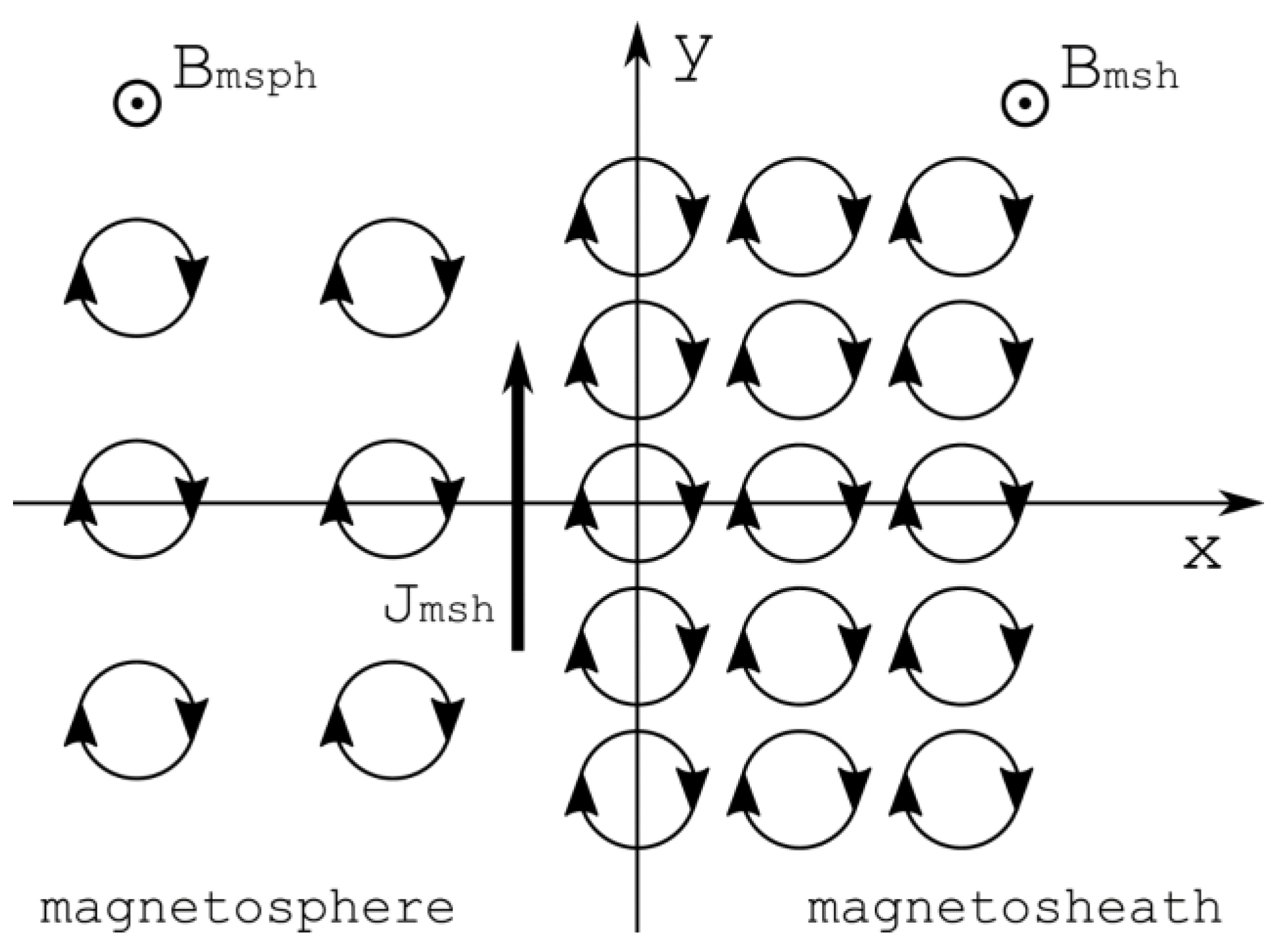What Density of Magnetosheath Sodium Ions Can Provide the Observed Decrease in the Magnetic Field of the “Double Magnetopause” during the First MESSENGER Flyby?
Abstract
:1. Introduction
2. Magnetopause Current Generated by Sodium Ions Penetrated from the Magnetosheath. Methods of Investigation
3. Results
4. Discussion and Conclusions
Author Contributions
Funding
Institutional Review Board Statement
Informed Consent Statement
Data Availability Statement
Acknowledgments
Conflicts of Interest
References
- Killen, R.; Cremonese, G.; Lammer, H.; Orsini, S.; Potter, A.E.; Sprague, A.L.; Wurz, P.; Khodachenko, M.L.; Lichtenegger, H.I.M.; Milillo, A.; et al. Processes that promote and deplete the exosphere of Mercury. Space Sci. Rev. 2007, 132, 433–509. [Google Scholar] [CrossRef] [Green Version]
- Slavin, J.; Acuña, M.; Anderson, B.; Baker, D.; Benna, M.; Gloeckler, G.; Gold, R.; Ho, G.; Killen, R.; Korth, H.; et al. Mercury’s magnetosphere after MESSENGER’s first flyby. Science 2008, 321, 85–89. [Google Scholar] [CrossRef] [PubMed]
- Mϋller, J.; Simon, S.; Wang, Y.-C.; Motschmann, U.; Heyner, D.; Schule, J.; Ip, W.-H.; Kleindienst, G.; Pringle, G. Origin of Mercury’s double magnetopause: 3D hybrid simulation study with A.I.K.E.F. Icarus 2012, 218, 666–687. [Google Scholar] [CrossRef]
- Belenkaya, E. Planetary magnetopause and heliopause current sheets. In Electric Currents in Geospacer and Beyond; Geophysical Monograph 235; Keiling, A., Marghitu, O., Wheatland, M., Eds.; AGU John Wiley & Sons, Inc.: Hoboken, NJ, USA, 2018; Chapter 13; pp. 207–218. ISBN 978-1-119-32449-2. [Google Scholar]
- Smith, D.E.; Zuber, M.T.; Phillips, R.J.; Solomon, S.C.; Hauck, S.A.; Lemoine, F.G.; Mazarico, E.; Neumann, G.A.; Peale, S.J.; Margot, J.-L. Gravity field and internal structure of Mercury from MESSENGER. Science 2012, 336, 214–217. [Google Scholar] [CrossRef] [PubMed] [Green Version]
- Alexeev, I.I.; Belenkaya, E.S.; Slavin, J.A.; Korth, H.; Anderson, B.J.; Baker, D.N.; Boardsen, S.A.; Johnson, C.L.; Purucker, M.E.; Sarantos, M.; et al. Mercury’s magnetospheric magnetic field after the first two MESSENGER flybys. Icarus 2010, 209, 23–39. [Google Scholar] [CrossRef]
- Sarantos, M.; Slavin, J.A.; Benna, M.; Boardsen, S.A.; Killen, R.M.; Schriver, D.; Trávnícek, P. Sodium-ion pickup observed above the magnetopause during MESSENGER’s first Mercury flyby: Constraints on neutral exospheric models. Geophys. Res. Lett. 2009, 36, L04106. [Google Scholar] [CrossRef]
- Cassidy, T.A.; Merkel, A.W.; Burger, M.H.; Sarantos, M.; Killen, R.M.; McClintock, W.E.; Vervack, R.J. Mercury’s seasonal sodium exosphere: MESSENGER orbital observations. Icarus 2015, 248, 547–559. [Google Scholar] [CrossRef]
- Raines, J.M.; DiBraccio, G.A.; Cassidy, T.A.; Delcourt, D.C.; Fujimoto, M.; Jia, X.; Mangano, V.; Milillo, A.; Sarantos, M.; Slavin, J.A.; et al. Plasma Sources in Planetary Magnetospheres: Mercury. Space Sci. Rev. 2015, 192, 91–144. [Google Scholar] [CrossRef] [Green Version]
- Belenkaya, E. Currents at the subsolar low shear magnetopause. JGR 2001, 106, 25437–25450. [Google Scholar] [CrossRef]
- Exner, W.; Simon, S.; Heyner, D.; Motschmann, U. Influence of Mercury’s exosphere on the structure of the magnetosphere. JGR 2020, 125. [Google Scholar] [CrossRef]
- Mϋller, J.; Simon, S.; Motschmann, U.; Schϋle, J.; Glassmeier, K.-H.; Pringle, G.A.I.K.E.F. Adaptive hybrid model for space plasma simulations. Comput. Phys. Commun. 2011, 182, 946–966. [Google Scholar] [CrossRef]
- Krupp, N.; Kotova, A.; Roussos, E.; Simon, S.; Liuzzo, L.; Paranicas, C.P.; Khurana, K.; Jones, G.H. Magnetospheric interactions of Saturn’s moon Dione (2005–2015). JGR 2020, 125. [Google Scholar] [CrossRef]


Publisher’s Note: MDPI stays neutral with regard to jurisdictional claims in published maps and institutional affiliations. |
© 2021 by the authors. Licensee MDPI, Basel, Switzerland. This article is an open access article distributed under the terms and conditions of the Creative Commons Attribution (CC BY) license (https://creativecommons.org/licenses/by/4.0/).
Share and Cite
Belenkaya, E.; Pensionerov, I. What Density of Magnetosheath Sodium Ions Can Provide the Observed Decrease in the Magnetic Field of the “Double Magnetopause” during the First MESSENGER Flyby? Symmetry 2021, 13, 1168. https://doi.org/10.3390/sym13071168
Belenkaya E, Pensionerov I. What Density of Magnetosheath Sodium Ions Can Provide the Observed Decrease in the Magnetic Field of the “Double Magnetopause” during the First MESSENGER Flyby? Symmetry. 2021; 13(7):1168. https://doi.org/10.3390/sym13071168
Chicago/Turabian StyleBelenkaya, Elena, and Ivan Pensionerov. 2021. "What Density of Magnetosheath Sodium Ions Can Provide the Observed Decrease in the Magnetic Field of the “Double Magnetopause” during the First MESSENGER Flyby?" Symmetry 13, no. 7: 1168. https://doi.org/10.3390/sym13071168
APA StyleBelenkaya, E., & Pensionerov, I. (2021). What Density of Magnetosheath Sodium Ions Can Provide the Observed Decrease in the Magnetic Field of the “Double Magnetopause” during the First MESSENGER Flyby? Symmetry, 13(7), 1168. https://doi.org/10.3390/sym13071168






